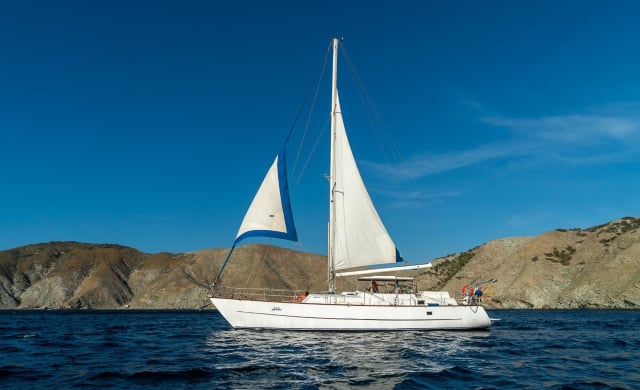It is likely that at some point you have heard or seen the elegant silhouette of a sailboat sailing majestically through the waters, gliding driven by the force of the wind and awakening a feeling of freedom and adventure. Unlike motor boats, sailboats do not depend on mechanical propulsion to move, but use the wind as their main source of energy , although there are sailboats that have both a sail and a motor in case any situation arises. , as for example, in places where there is not enough wind or to maneuver in ports.
Sailing is a fascinating way of moving through the water using the wind as a source of energy where it is essential to understand the cardinal points and the relationship between the direction of the wind and the direction of the sailboat. Since many years ago, the sail has been a fundamental tool to explore new territories, trade and compete in exciting regattas. This type of sailing is based on simple but powerful physical principles where the wind propels the boat by inflating the sails and creating a force that pushes the boat forward. The objective of the navigator is to make the most of it to control the direction and speed in which they move.
There are different sailing angles in relation to the wind, such as upwind heading, which is sailing against the wind, across heading, which is sailing perpendicular to the wind, and downwind heading, which is sailing downwind. For this reason, the crew or the navigator must learn to adjust the sails and the position of the rudder to obtain better performance in each heading . Likewise, the boater must be aware of other factors, such as the ocean current, obstacles in the water and changing weather conditions. Also, knowledge of navigation rules, maritime signals and security techniques, essential for safe navigation. In fact, there is a sport where these skills are measured and it is in regattas, which bring together competitors from all over the world to demonstrate these skills and strategies.
You may also be interested in: Jeanneau sailboats
parts of a sailboat
Sailboats are made up of various parts that work together to allow navigation. Here are some of the most important parts of a sailboat:
-
Hull: It is the main structure of the boat, usually in a V shape to cut through the water efficiently. It can be made of different materials such as fiberglass, wood or metal.
-
Deck: It is the upper surface of the boat that covers the hull where different features are located, such as the cockpit (open area in the back of the sailboat), the hatches (storage compartments) and the handrails (safety rails).
-
Mast: it is a vertical structure that is in the center of the boat and supports the sails. It can be in one piece or be made up of several sections.
-
Boom: is a horizontal bar that extends from the mast and is used to control the position of the mainsail. The boom allows you to adjust the angle and tension of the sail.
-
Sails: some of the most common sails are the mainsail (the largest and located on the main mast), the headsail (located at the front of the boat) and the genoa or jib sails (triangular sails in the bow ).
-
Rigging: they are the set of cables and ropes that hold and adjust the sails and the mast. Rigging includes the forestay (cable that holds the mast forward), shrouds (cables that hold the mast out to the lakes), and other rigging and halyards that allow control of the sails.
-
Rudder: It is a vertical surface submerged in the water, located at the rear of the sailboat. It allows the navigator to control the direction of the sailboat. It can be controlled manually or through more sophisticated steering systems.
You may also be interested in: Dufour sailboats
Types of sailboats
There are several types of sailboats, each designed for different purposes and sailing conditions. For example:
-
Cruising Yacht: These sailboats are designed for pleasure and comfort on long voyages. They usually have a spacious cabin, comfortable cabins and modern equipment. They are suitable for ocean crossings and long distance sailing.
-
Catamaran: they are known for their stability and wide interior space. Catamarans are popular on ocean voyages and for those looking for comfort and space on deck.
-
Ketch: It is a two-masted sailing ship with the main mast in front of the stern. They are typically used for cruising and offer greater flexibility in terms of sail options and balance points.
-
Yawl – Similar to the Ketch, the yawl also has two masts, but the aft mast is located aft of the rudder line. The tailsail is smaller and is used primarily to balance the boat.
-
Trimaran: It has three hulls, with a larger central hull and two smaller outer hulls. They are fast and stable, making them a popular choice for high-speed racing and touring.
-
Dinghy – Dinghies are small sailboats, usually one or two person. They are used for training, recreation and racing in inland waters. They can be dinghies like the Optimists, or rigged inflatable boats.
You may also be interested in: Sunreef Catamarans
price of a sailboat
The cost of new sailboats can vary widely depending on the size, make, equipment and specifics of each boat. For example:
-
Beneteau Oceanis 38.1 – is a well-known sailboat manufacturer and the Oceanis 38.1 is a popular model. Its price can vary between 150,000 and 200,000 dollars.
-
Jeanneau Sun Odyssey 419 : The price of this new sailboat can be around 200,000 to 300,000 dollars.
-
Bavaria Cruiser 37: can have an approximate price of 180,000 to 250,000 dollars.
-
Hanse 415 – Found in the price range of approximately $220,000 to $270,000.
-
Dufour 430 Grand Large: It can have an approximate price of 250,000 to 300,000 dollars.
-
X-Yachts X4.0 : It has an approximate price of about 400,000 to 500,000 dollars.
-
Swan 54: the price can range between 1,000,000 and 2,000,000 dollars.
-
Hallberg-Rassy 44: Has an approximate price of $600,000 to $800,000.
-
Oyster 565: Found in the price range of approximately $2,000,000 to $3,000,000.
It is important to note that prices are approximate and may vary based on customization options, additional equipment, and market fluctuations. In addition, there are brands of sailboats that are more exclusive and personalized that can have much higher prices. If you are interested in a new sailboat, it is recommended that you visit the sailboat manufacturers' websites for up-to-date information on prices and specific models.
You may also be interested in: Bali Catamarans
What documents are needed to buy a sailboat?
The documents and requirements needed to purchase a sailboat may vary in each country and, in some cases, may depend on local regulations and the specific circumstances of the transaction. For example, below you will find some necessary documents depending on the country:
In United States:
-
Valid personal identification (passport or driver's license)
-
Tax identification number (such as social security number or individual tax identification number)
-
Proof of address (utility bill, bank statement, etc.)
-
Sales document or sales contract
-
Sailboat title deed (if previously registered)
-
Vessel registration (if required by the state where the purchase will be made)
-
Payment of sales or use tax (depending on state laws)
In Spain:
-
Valid identity documentation (ID card or passport)
-
Registration certificate (to prove address)
-
Sales document or sales contract
-
Deed of ownership or lease of the mooring (if applicable)
-
Sailboat title deed
-
Maritime Registration Documentation (if applicable)
In France:
-
Valid identity document (carte d'identité or passport)
-
Proof of address (utility bill, rental contract, etc.)
-
Sales document or sales contract
-
Registration certificate or sailboat flag (if registered)
-
Navigability certificate (if applicable)
In Mexico:
-
Official identification (INE or passport)
-
Proof of address
-
Sales document or sales contract
-
Original invoice or import document (if it is a foreign sailboat)
-
Sailboat title deed
-
Navigation permit (if applicable)
In colombia:
-
Valid identity document (citizenship card or passport)
-
Certificate of address or utility bill
-
Sales document or sales contract
-
Sailboat title deed
-
Registration of the vessel in the Harbor Master's Office
Although these are some of the general documents that may be requested, there may also be specific requirements that may vary depending on local regulations and the circumstances of the purchase. It is recommended to check with the competent authorities and seek legal advice to ensure that you meet all the necessary requirements in the relevant country.
Recommendations for buying a sailboat
If you are interested in buying a sailboat, you should keep in mind that before starting the search, you must clearly determine your needs and expectations ; that is, you must consider what you want the sailboat for (for what purpose), for how many people, the type of trips you are going to make and your navigation skills (if you are going to maneuver it yourself).
Subsequently, you must think of a maximum budget that you are willing to invest in the purchase of the sailboat and take into account not only the initial price, but also the maintenance, insurance, mooring and other possible associated expenses.
Likewise, you should investigate and compare different options , between brands, models, sizes, prices, features, brand reputation, performance in the water, opinions of other owners and everything you need in order to find the one that best suits you. your needs.
Once you have found the ideal yacht and before finalizing the purchase, carry out a detailed inspection of the sailboat. Check the condition of the hull, keel, rigging, sails, electrical system, plumbing, and other essential components. Even more so if the boat is second-hand, you must request the maintenance history with the seller and the repairs made to the sailboat. Also, take a test ride in the water and watch how it rides, check its handling, and pay attention to any strange noises or potential problems it may have.
As mentioned above, you must consider the costs of mooring in a port or marina and regular maintenance expenses , such as cleaning, antifouling paint and mechanical revisions.
Additionally, you should research your sailboat insurance options and make sure you comply with all legal and registration requirements in the country where you will be using it . Finally, make sure you have received all the legal documents necessary to transfer ownership of the sailboat , such as the title deed, sales contract and any other documents required by the maritime authorities.
Remember that the purchase of a boat is an important investment and it is essential to carry out a thorough investigation and obtain as much information as possible to make the right decision.
We invite you to take a look at other articles at: https://yate.co/es/blog


